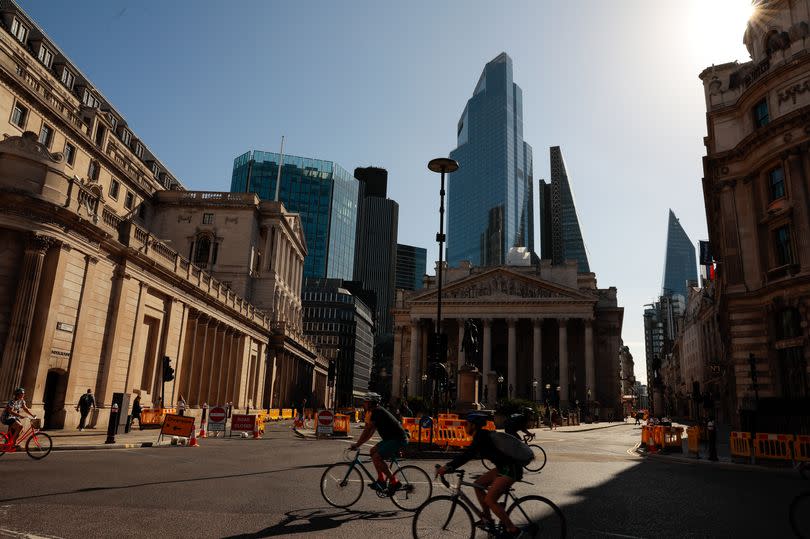Black cabs should not be allowed back into Bank Junction on weekdays, council recommended

Black cabs should not be allowed back into Bank Junction on weekdays, City of London officers have recommended, with data showing a ‘significant’ reduction in collisions since restrictions were enforced in May 2017.
City of London members will next week vote on whether to recommend Bank Junction be fully reopened to licensed taxis, with a final decision to then be made by the Court of Common Council. Any changes will also require an application to Transport for London (TfL).
The restrictions limit the junction to use by cyclists and buses between 7am and 7pm Monday to Friday. They were introduced in a bid to improve safety, following incidents including the death of 26-year-old Ying Tao in 2015, who was crushed by an HGV while riding to work.
READ MORE: Next London mayor and TfL told to protect black cabs at risk of 'going extinct'
A review of the scheme was approved in April 2022 after a motion calling for a reassessment was passed by the City of London Corporation.
Alderman Timothy Hailes, who has spoken publicly against the restrictions, said that licensed Hackney carriages 'fulfil an essential public service in terms of both accessibility and women’s safety, are environmentally friendly and should be treated consistently with buses'.
Architect and cycling campaigner Peter Murray has, however, urged members not to 'spoil the good work you have already done in turning a deadly junction into an enjoyable space'.
In documents prepared ahead of next week’s Planning and Transportation Committee meeting (May 16), City of London officers wrote the review was informed by the need to further analyse the potential equalities impacts of the restrictions.
An Equality Impact Assessment drawn up by the consultancy Steer, dated April 2024, however, concluded the scheme 'has not led to any extensive negative impacts on equality and the impacts on the restrictions outside of these hours is deemed to be negligible'
It does add that certain groups have been affected, including some disabled people and pregnant women reliant on taxis.
Separate data compiled for the City found casualty figures have dropped significantly in the Bank area since the restrictions were introduced. The committee’s report notes the average between 2014 and 2016 during the 7am to 7pm period was 14 per year, with 13 in 2017. Since then, the numbers have dropped to an average of nine between 2018 and 2021, excluding 2020, three in 2022, and one in 2023, up to November 30.
Officers wrote their review “found no transport grounds or strong equality grounds for making a change to the restrictions to allow taxis during restricted hours”, and that they recommend the current scheme remains in place.
'High time the issue was resolved'
Steve McNamara, general secretary of the Licensed Taxi Drivers Association, said members actively avoid the area around Bank Junction due to the scheme, leaving certain passengers without access to the door-to-door service they rely on.
He continued: “The officer’s report and findings to be presented to the Committee are based on data compiled by a consultancy with little understanding of the taxi trade and how things work in practice, and in fact seem to contradict data supplied by the leading taxi apps themselves such as Gett and FREENOW, which has clearly shown much longer waiting times and high rates of cancelled or unfulfilled jobs in and around the Bank area.
“The problems are clear and have been from the start. Restoring taxi access will have no significant impact on the benefits being delivered by the scheme whilst greatly benefiting taxi users, including disabled passengers and making the area more accessible for everyone. It’s high time this issue was resolved, and we hope the committee will make the right decision to move ahead with giving taxis the access they need.”
Alderman Hailes said his position has been clear since the original ‘Bank on Safety’ consultation: “That licensed Hackney carriages fulfil an essential public service in terms of both accessibility and women’s safety, are environmentally friendly and should be treated consistently with buses.”
He added no safety breaches have occurred involving Hackney carriages at Bank, with the ‘biggest hazard’ now being cyclists failing to observe 'basic road traffic compliance'.
“It is ironic because our original motivation for addressing the issues at Bank turned substantively on the interests of pedestrians and cyclists by reducing vehicular traffic,” he said.
Mr Murray however is among those to have spoken positively of the changes. He told the LDRS the City of London has been making ‘great progress’ over the last decade, including its work on the ‘dysfunctional’ Bank Junction.
He said: “Whether in Copenhagen, Paris, Melbourne or New York, leaders of major cities understand that they must create places people want to be in if they are to be successful. The City is doing well with the new park at Aldgate, improvements around Liverpool Street and the proposals for the St Paul’s gyratory. It would be a backward step to increase the traffic through the Bank Junction.
“My message to the committee is - don’t spoil the good work you have already done in turning a deadly junction into an enjoyable space where City workers can sit out and enjoy a coffee instead of dodging the traffic.”
The report on Bank Junction is set to appear before the City’s Streets and Walkways Sub-Committee on May 14, before going to the Planning and Transportation Committee two days later. It will then go to the Court of Common Council for a final decision.
Get the biggest stories from around London straight to your inbox. Sign up to MyLondon's The 12 HERE for the 12 biggest stories each day.

 Yahoo News
Yahoo News 
